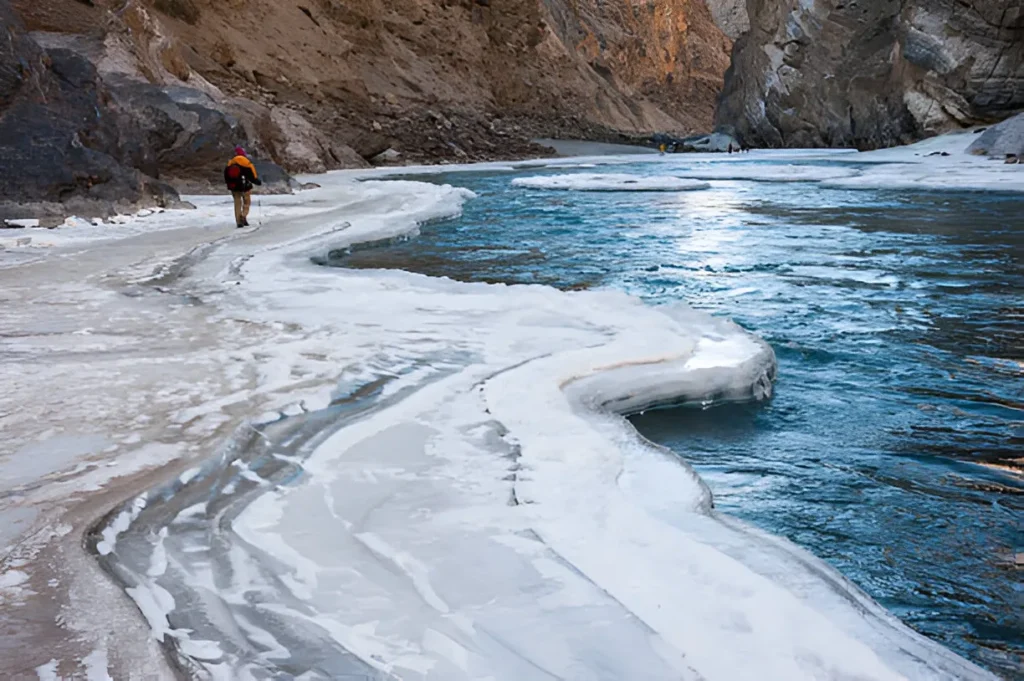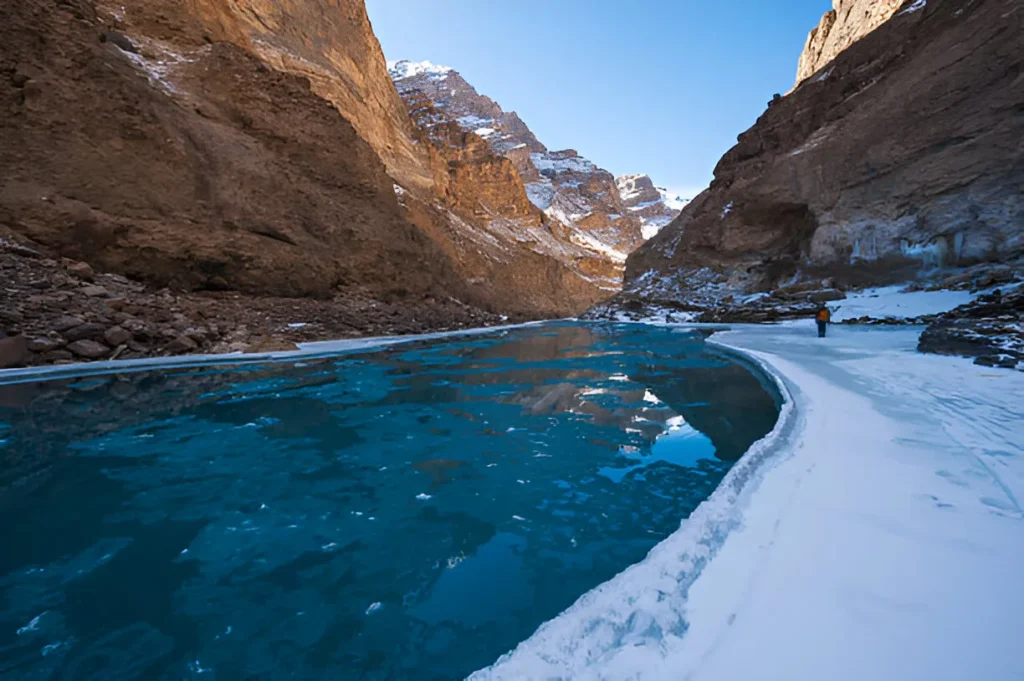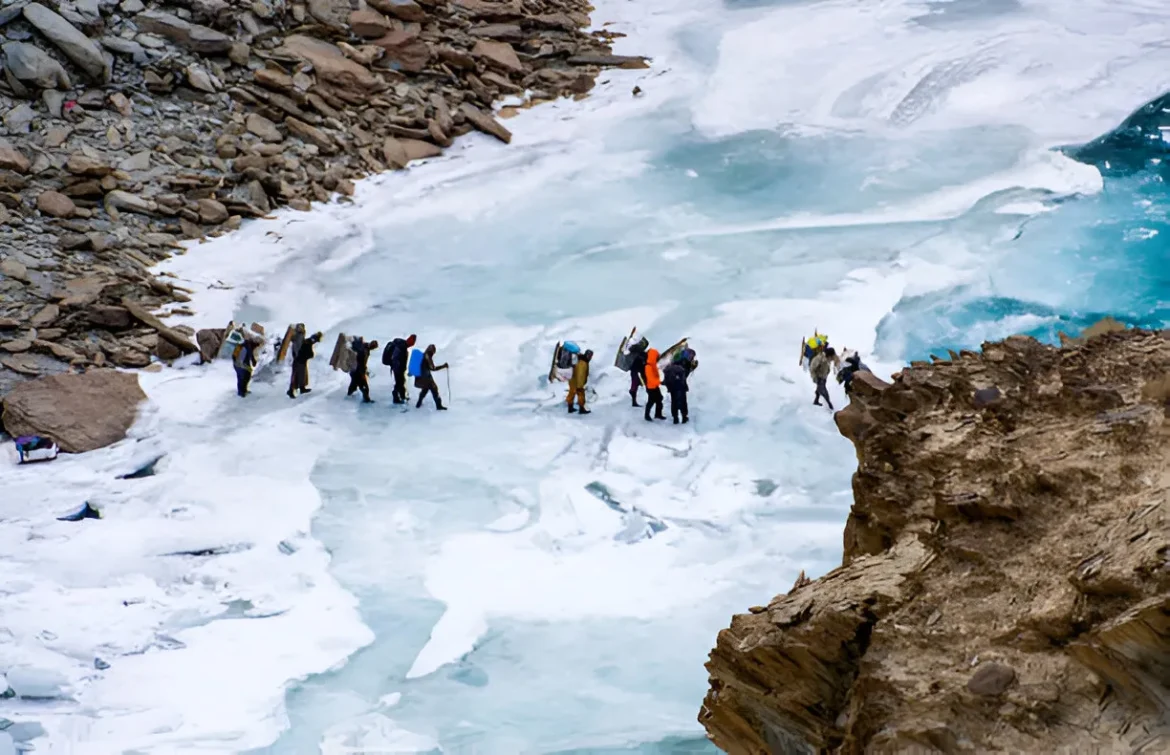Table of Contents
The Chadar Trek is an adventure in the Indian Himalayas that’s truly unique. It crosses the frozen Zanskar River, which looks like a winter wonderland. You’ll see amazing views of the Himalayas and learn about Ladakh’s culture.
Key Takeaways
- The Chadar Trek is a thrilling winter adventure in the heart of Ladakh, India.
- Trekkers will journey across the frozen Zanskar River, witnessing stunning Himalayan landscapes.
- The trek tests adventurers’ endurance, pushing them to their limits.
- Participants will have the opportunity to immerse themselves in the rich cultural heritage of Ladakh.
- The Chadar Trek is a unique and unforgettable experience for those seeking a true Himalayan adventure.
Overview of The Chadar Trek: Frozen River
| Location | Main Market, Leh, Jammu and Kashmir 194101 |
| Duration | 8 Days |
| Adventure Type | Trekking |
| Base Camp | Leh |
| Season | Winter |
| Months | December |
| Altitude | 11,100 ft |
| Grade | Difficult |
| Accommodation | Hotel (Separate male & female) & Camping |
| Location | Ladakh |
| Distance | 62 km |
| Nearest Airport | Leh (Kushok Bakula Rimpochee) |
A winter adventure on the Chadar Trek.
The Chadar Trek is a thrilling winter adventure. Travelers can cross the frozen Zanskar River in Ladakh, India, on this journey. This trek lets you see the Himalayas covered in snow and ice. It also challenges you in a unique way.
Picture walking on a frozen river, with cliffs and mountains all around. The Chadar Trek, or Frozen River Trek, is a chance to see the Ladakh trekking trails in winter. It’s a journey you’ll never forget.
When you start the Chadar Trek, you’ll feel like you’re in a dream. The frozen river is your path through a magical world. It’s a trek that takes you through a landscape from a fairytale.
“The Chadar Trek is a truly transformative experience, a journey that will challenge both your body and your spirit.” – Rahul, a seasoned trekker
Walking on the icy ground, you’ll see the frozen river change before your eyes. Each step shows you a new view of this winter wonderland. The Chadar Trek is more than a hike; it’s an adventure that changes you.
Whether you’re experienced or new to winter trekking, the Chadar Trek is a must-do. It lets you dive into the beauty and grandeur of Ladakh. Get ready to be amazed by the frozen beauty and the feeling of achievement you’ll get.

Who Can Participate?
- Age Requirement: All participants must be 12 years or older.
- Experience: First-time trekkers are welcome to apply. However, prior trekking experience is highly valued.
- Physical Fitness: Participants should be physically fit, capable of covering 5 kilometers within 35 minutes without undue stress.
- Required Backpack: Climbers must carry a backpack that weighs between 10 and 15 kilograms.
Why the Chadar Trek is a Must-Do Adventure
The Chadar Trek, a unique and challenging expedition in the heart of Ladakh, India, offers an unforgettable experience for adventure seekers. Here’s why it’s considered a must-do:
1. Unique Terrain and Scenery
- Frozen Riverbed: The trek takes you on a journey across the frozen Zanskar River, a surreal landscape of ice formations, crevasses, and stunning vistas.
- High-Altitude Deserts: Experience the stark beauty of the cold desert landscape, surrounded by snow-capped mountains and crystal-clear skies.
- Frozen Waterfalls: Witness the mesmerizing sight of frozen waterfalls cascading down the cliffs, creating a breathtaking spectacle.
2. Challenging Adventure
- Physical Endurance: The trek demands physical fitness and stamina, as you navigate icy terrain and endure sub-zero temperatures.
- Mental Fortitude: The isolation and harsh conditions test your mental resilience and determination.
- Sense of Accomplishment: Completing the Chadar Trek provides a profound sense of achievement and personal growth.
3. Cultural Immersion
- Local Villages: Interact with the friendly and hospitable Zanskari people, learning about their traditional way of life and customs.
- Remote Beauty: Experience the tranquility and isolation of a region untouched by mass tourism.
4. Unforgettable Experience
- Once-in-a-Lifetime Opportunity: The Chadar Trek offers a unique and unforgettable adventure that you’ll cherish for years to come.
- Personal Growth: The challenges and rewards of the trek can lead to significant personal growth and self-discovery.
If you’re seeking a truly extraordinary adventure that combines stunning scenery, physical challenges, and cultural immersion, the Chadar Trek is a must-do.
Trekking Difficulty and Fitness Requirements
The Chadar Trek is a moderately challenging trek that requires a good level of fitness to complete. Here’s a breakdown of the difficulty and fitness requirements:
Factors Contributing to Difficulty:
- Terrain: The trek involves walking on a frozen river, which can be slippery and uneven. There may also be sections with steep ascents and descents.
- Altitude: The trek takes place at high altitudes (around 11,500 feet), which can affect breathing and energy levels.
- Weather: Temperatures can drop below -30°C, making it important to be prepared for cold and harsh conditions.
- Endurance: The trek involves walking for 5–6 hours per day with a backpack, covering a distance of around 14–15 km.
Fitness Requirements:
- Cardiovascular endurance: Good cardiovascular fitness is essential for handling the challenges of high altitudes and long distances. Regular aerobic exercises like running, cycling, or swimming can help improve endurance.
- Strength: Strong leg and core muscles are important for maintaining balance and stability on icy terrain. Strength training exercises like squats, lunges, and planks can help build these muscles.
- Flexibility: Good flexibility can help reduce the risk of injuries and improve comfort during the trek. Stretching exercises can help improve flexibility.
Preparation:
- Training: Engage in regular cardio and strength training exercises for several months before the trek to build up your fitness levels.
- Acclimatization: Spend a few days acclimatizing in Leh or another high-altitude town to adjust to the altitude.
- Practice: If possible, practice walking on ice or snow to prepare for the conditions on the trek.
- Gear: Proper trekking gear, including warm clothing, sturdy footwear, and a backpack, is essential.
Additional Tips:
- Hydration: Stay hydrated throughout the trek, as dehydration can be a problem at high altitudes.
- Nutrition: Eat plenty of carbohydrates and protein to provide energy for the trek.
- Pace yourself: Walk at a comfortable pace and take breaks as needed to avoid fatigue.
- Listen to your body: If you feel unwell or exhausted, don’t hesitate to rest or turn back.
While the Chadar Trek is considered a moderately challenging trek, it’s important to assess your fitness levels and experience before undertaking it. If you’re new to trekking or have any concerns about your fitness, it’s recommended to consult with a doctor or experienced trekking guide before making a decision.

When is the Best Time for the Chadar Trek?
The Chadar Trek is a magical winter journey in Ladakh’s stunning landscapes. It’s best done from mid-January to mid-February. This is when the Zanskar River is most frozen, making it safe for trekkers.
Ladakh is covered in a beautiful, icy landscape during this time. The Chadar Trek lets you walk on the frozen river. It’s a challenge that outdoor lovers shouldn’t miss.
Planning your Chadar Trek right ensures the best experience and weather. By trekking during Ladakh’s ideal winter season, you’ll enjoy the stunning views and unique experience of crossing the frozen Zanskar River.
Map
How to Reach the Chadar Trek
1. Getting to Leh, Ladakh
The first step to reaching the Chadar Trek is to get to Leh, the capital city of the Union Territory of Ladakh. Leh is well-connected by air, but becomes isolated by road during the winter months due to heavy snowfall.
By Air:
- Flight to Leh Airport (Kushok Bakula Rimpochee Airport): The most convenient way to reach Leh is by taking a direct flight from major cities like Delhi, Mumbai, or Srinagar. The flight duration from Delhi to Leh is approximately 1.5 hours. Winter flights can be subject to weather conditions, so it’s advisable to book well in advance and keep a few days’ flexibility.
- Tips for Air Travel:
- Due to Leh’s high altitude (11,500 feet), acclimatization is crucial. Spend at least 2 days in Leh before starting the trek to adjust to the altitude and avoid Acute Mountain Sickness (AMS).
By Road:
- Road Journey to Leh: During the winter, road access to Leh via the Srinagar-Leh or Manali-Leh highways is closed due to heavy snowfall. Thus, reaching Leh by road in winter is generally impossible.
2. From Leh to Chilling (Base Camp)
The Chadar Trek starts from a small village called Chilling, located about 65 kilometers from Leh. After acclimatizing in Leh, the next step is to reach Chilling, the starting point of the trek.
By Road:
- Private Taxi or Shared Cabs: You can hire a private taxi or opt for shared cabs from Leh to Chilling. The journey takes about 3 to 4 hours, depending on road conditions and weather.
- Route Details: The route from Leh to Chilling passes through picturesque landscapes and follows the banks of the Zanskar River. However, the roads can be slippery and icy during winter, requiring careful driving.
Day-by-Day Itinerary: The Chadar Trek Experience
Day 1: Arrival in Leh
- Altitude: 11,400 ft
- Highlights: Acclimatization and exploration of Leh
- Details: Upon arrival in Leh, spend the day acclimatizing to the high altitude. Explore the local markets and monasteries, and prepare for the adventure ahead.
Day 2: Medical Check-up and Briefing
- Altitude: 11,400 ft
- Highlights: Mandatory medical check-up and trek briefing
- Details: Participate in a mandatory medical check-up to ensure you’re fit for the trek. Attend a detailed briefing about the trek, safety protocols, and the challenges ahead.
Day 3: Leh to Chilling and Trek to Tilad Do
- Altitude: 10,390 ft (Tilad Do)
- Distance: 3 km trek
- Highlights: First encounter with the frozen Zanskar River
- Details: Drive from Leh to Chilling, the starting point of the trek. Begin the trek along the frozen Zanskar River, also known as the Chadar, and reach Tilad Do by evening.
Day 4: Tilad Do to Shingra Koma
- Altitude: 10,550 ft
- Distance: 10 km trek
- Highlights: Trekking on the Chadar and icy landscapes
- Details: Continue trekking on the frozen river, surrounded by towering cliffs and icy terrain. Reach Shingra Koma, where you’ll set up camp for the night.
Day 5: Shingra Koma to Tibb Cave
- Altitude: 10,760 ft
- Distance: 15 km trek
- Highlights: Ice formations and stunning views
- Details: Trek through a stunning landscape of ice formations and frozen waterfalls. Arrive at Tibb Cave, a natural shelter, where you’ll camp for the night.
Day 6: Tibb Cave to Nerak
- Altitude: 11,150 ft
- Distance: 12 km trek
- Highlights: Iconic frozen waterfall at Nerak
- Details: This is the most challenging, yet rewarding day of the trek. Reach Nerak by afternoon and witness the famous frozen waterfall. Spend the night in a homestay or tent.
Day 7: Nerak to Tibb Cave
- Altitude: 10,760 ft
- Distance: 12 km trek
- Highlights: Return journey on the Chadar
- Details: Retrace your steps back to Tibb Cave, enjoying the serene beauty of the frozen river and the tranquility of the surroundings.
Day 8: Tibb Cave to Shingra Koma
- Altitude: 10,550 ft
- Distance: 15 km trek
- Highlights: Trekking back through familiar terrain
- Details: Continue your return journey, trekking back to Shingra Koma. The familiarity of the path offers a chance to appreciate the scenery from a new perspective.
Day 9: Drive to Leh from Shingra Koma and Tilad Do
- Altitude: 11,400 ft (Leh)
- Distance: 3 km trek + 65 km drive
- Highlights: Final trek and return to civilization
- Details: Complete the final stretch of the trek, returning to Tilad Do. Drive back to Leh, where you can relax and celebrate the completion of the Chadar Trek.
Day 10: Departure from Leh
- Altitude: 11,400 ft
- Highlights: Departure
- Details: Depart from Leh with unforgettable memories of the Chadar Trek and the unique experience of walking on a frozen river.
Note:
- Buffer Days: Include 1-2 buffer days in your plan. If not needed, use them to explore Leh.
- Trekking Details: Distances, altitudes, and hours are approximate.
- ID Proof: Keep both the original and a copy of your ID handy.
- Arrival: If flying, arrive a day early to allow for acclimatization.
Cost Breakdown: Expenses for the Chadar Trek
Are you planning a Chadar Trek in Ladakh? It’s important to know the typical costs to budget well for this frozen river adventure. The Chadar Trek cost and Ladakh trek expenses change based on several things. But, knowing the main costs can make your trekking experience smooth and fun.
Permits and Fees
You need trekking permits for Ladakh. These permit costs are often part of the package price. But, always check with your tour operator about the specific permits and fees.
Gear and Equipment Rentals
The Chadar Trek needs special gear and equipment for safety on the frozen river. Many tour operators offer rentals for warm clothes, sleeping bags, ice axes, and crampons. Make sure to include the cost of these rentals in your Chadar Trek cost.
| Item | Approximate Cost (INR) |
| Warm Jacket Rental | 300-500 per day |
| Sleeping Bag Rental | 200-400 per day |
| Ice Axe Rental | 100-200 per day |
| Crampons Rental | 100-200 per day |
The Chadar Trek cost and Ladakh trek expenses can change depending on the tour operator, group size, and services included. Do your research and budget well for a memorable Chadar Trek.
Chadar Trek Essentials: Gear and Packing List
The Chadar Trek demands proper gear to handle extreme cold and challenging conditions. Here’s a concise packing list to help you prepare:
1. Clothing (Layer Up)
- Base Layer: Thermal tops and bottoms (2 pairs) for warmth.
- Mid Layer: Fleece jacket and insulated down jacket.
- Outer Layer: Waterproof and windproof jacket and pants.
- Lower Body: Trekking pants (2-3 pairs) and insulated pants.
- Accessories: Woolen hat, balaclava, sunglasses, waterproof gloves, woolen socks, gaiters, and high-ankle, waterproof trekking boots.
2. Sleeping Gear
- Sleeping Bag: Rated for -20°C to -30°C, ideally down-filled.
- Sleeping Mat: Insulated mat for ground comfort and warmth.
3. Trekking Equipment
- Trekking Poles: For stability on ice.
- Microspikes or Crampons: Essential for grip.
- Daypack (20-30 liters): For daily essentials.
- Backpack (50-60 liters): For all your gear.
4. Personal Gear
- Water Bottles/Thermos: Insulated to prevent freezing.
- Headlamp with Extra Batteries: For nighttime use.
- Sunscreen, Lip Balm, Toiletries: Protect skin and hygiene.
- First Aid Kit: Include basic medications and altitude sickness pills.
- Power Bank: For charging devices.
5. Food and Nutrition
- Energy Bars, Nuts, Ready-to-Eat Meals: Quick, lightweight options.
- Electrolyte Powder: For hydration.
6. Miscellaneous Items
- ID Proof and Permits: Required for the trek.
- Cash: For expenses, as ATMs may not be available.
- Camera: To capture the adventure.
Packing Tips
- Waterproof Everything: Use dry sacks to protect gear.
- Keep It Light: Prioritize essentials to reduce weight.
Relevant Content: Sar Pass Trek – Trek Guide, Best Time to Visit, and How To Reach
Frequently Asked Questions
What is the Chadar Trek?
The Chadar Trek is a thrilling winter adventure across the frozen Zanskar River in Ladakh, India. It’s a challenging trek that lets adventurers see stunning Himalayan landscapes. It’s a unique way to test your limits in a beautiful setting.
Why is the Chadar Trek a must-do adventure?
The Chadar Trek is a must-do for many reasons. It offers breathtaking natural beauty, with trekkers crossing the frozen Zanskar River. The trek is also a test of endurance, challenging you with tough terrain and weather.
What is the difficulty level and fitness requirement for the Chadar Trek?
The Chadar Trek is moderately difficult. You’ll need good physical fitness and some trekking experience. Be ready for the frozen river, steep sections, and extreme cold.
Who can participate in the Chadar Trek?
Anyone can join the Chadar Trek, from experienced trekkers to adventure lovers. But, think about your fitness and health before going. Talk to a doctor if you’re young or old.
What are the highlights of the Chadar Trek route?
The trek takes you through stunning Himalayan landscapes along the frozen Zanskar River. You’ll see the Chilling village, Nerak waterfall, and the amazing Tibb Campsite. It’s an unforgettable journey.
How can I reach the starting point of the Chadar Trek?
Getting to the Chadar Trek start is a bit tricky. Ladakh is far away. You can fly into Leh or drive from cities like Srinagar or Manali. This makes your journey smooth and easy.
What are the typical expenses for the Chadar Trek?
The cost of the Chadar Trek varies by tour operator and services included. You’ll pay for permits, gear rental, and other expenses. Plan your budget to enjoy the trek without stress.
What gear and equipment do I need for the Chadar Trek?
You’ll need special gear for the Chadar Trek due to the harsh winter and tough terrain. Bring thermal clothes, strong boots, and a good sleeping bag. This will keep you safe and comfortable.
What is the typical day-by-day itinerary for the Chadar Trek?
The Chadar Trek lasts 7-8 days, starting with arrival and preparation. Then, you’ll trek along the frozen river, facing new challenges and beauty each day. You’ll see snow peaks and frozen waterfalls, making it an unforgettable trip.
What is the best time to undertake the Chadar Trek?
The best time for the Chadar Trek is mid-January to mid-February. The Zanskar River is fully frozen then, making it safe for trekkers. Plan your trip during this time for the best experience.

